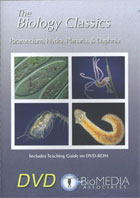
The Biology Classics: Paramecium, Hydra, Planaria & Daphnia 2006
Distributed by BioMEDIA Associates, PO Box 1234, Beaufort, SC 29901-1234; 877-661-5355
Produced by BioMEDIA ASSOCIATES
Director n/a
DVD, color, 31 min.
Jr. High - Sr. High
Biology, Science
Date Entered: 02/06/2007
Reviewed by Carrie M. Macfarlane, Reference and Instruction Librarian for the Sciences, Middlebury College, Middlebury, VTScience is fun because it offers a promise of discovery. As the action unfolds in The Biology Classics: Paramecium, Hydra, Planaria & Daphnia, students will feel like they're discovering the diversity of life firsthand. With clear and captivating video footage and an engaging narrative broken up into short, thematic modules, this DVD can be a rich addition to middle- and high-school science classes.
Each organism is featured in its own chapter, and each chapter is divided into modules with topics such as movement, hunting and feeding, and reproduction. The modules are just two to three minutes long, allowing for focused discussion. The DVD includes a 21-page teaching guide but you must open the file on a computer to access it. Those without a DVD drive can acquire the guides on the BioMEDIA web site.
The video footage is crisp and colorful, but it's the narrative that makes this title stand out. The script enforces firsthand learning by posing questions and allowing them to be answered through observation. When the camera shows planaria growing alert to an earthworm dropped in a fish tank the narrator asks, "How do they hone in on the food?" The planaria waggle across the tank and find the earthworm. The narrative doesn't resume until enough time has elapsed for students to develop a hypothesis on how this happened.
This method of questioning and observation also is used to introduce lab techniques. In the "Cell Surface" module of the paramecium chapter, the narrator tells the viewer to watch what happens when crystal violet dye seeps onto a glass slide holding a paramecium. In a dramatic display of self-defense, all trichocysts fire off in unison and the cell becomes an inert, hairy mess. Students will feel like they've tried this in the lab themselves.
This DVD is thoughtfully produced, with fascinating video footage and a well-scripted narrative. It is highly recommended for middle- and high school classroom use.